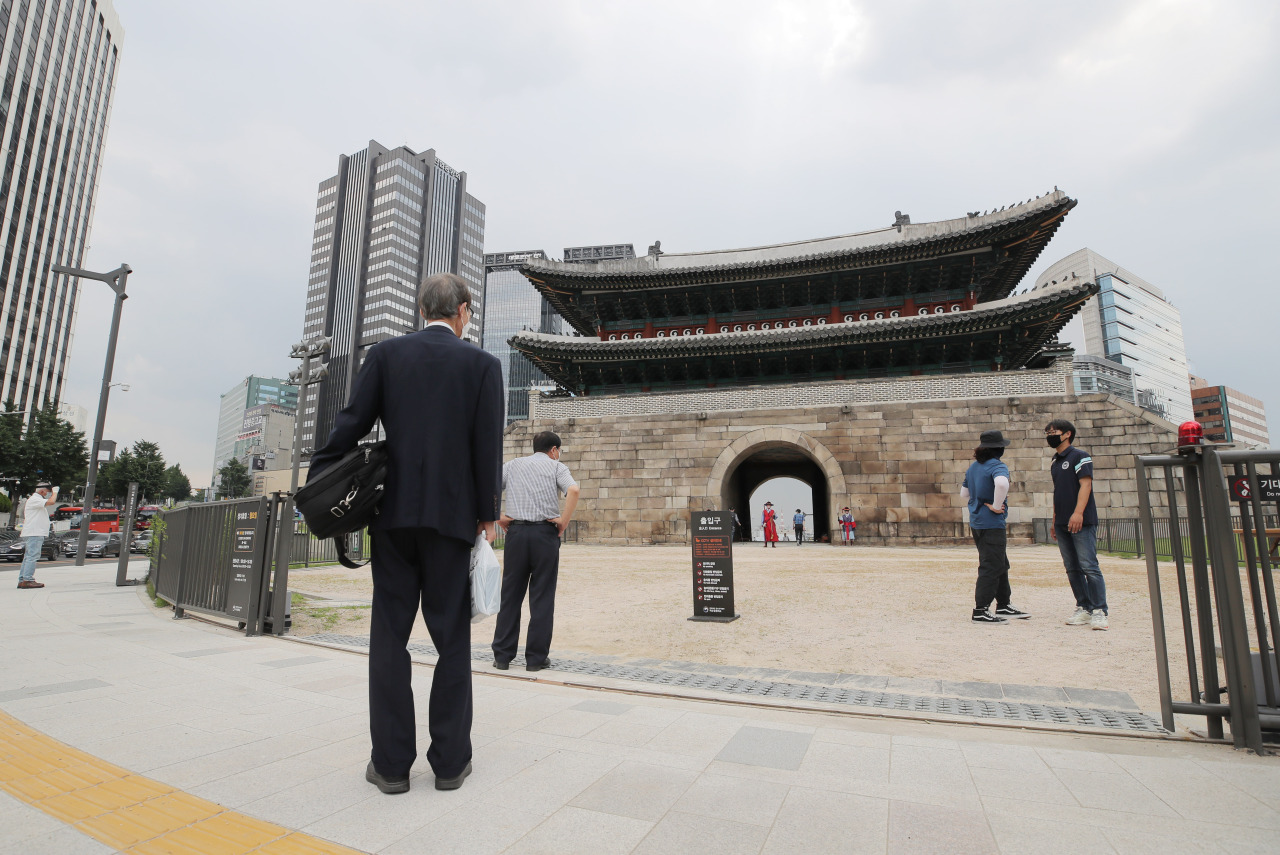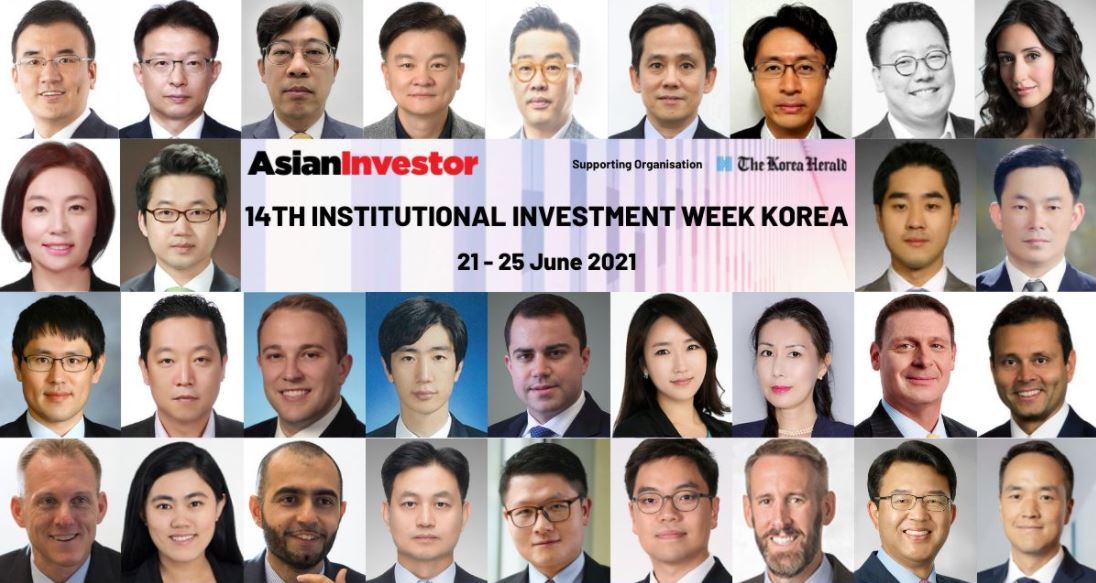 |
Pedestrians stand in front of the city gate Sungnyemun in central Seoul. (Yonhap) |
As global central banks talk of tapering the huge liquidity provisions they made to cope with the fallout from the COVID-19 pandemic, South Korean asset owners are rethinking their current asset allocation strategies.
The 14th Institutional Investor Week Korea, a virtual conference hosted by Hong Kong-based publication AsianInvestor from June 21-25, invited discussions of how Korean institutional investors were preparing for the possibility of increased inflation and interest rate hikes.
Historically low interest rates and aggressive monetary and fiscal stimulus packages not only cushioned the market impact from the pandemic, but also allowed investors to capitalize on the swift price recovery of certain asset classes, including listed stocks.
The approach, however, appears unlikely to be sustainable as global financial policymakers begin to discuss policy normalization.
Korean investors’ eyes are fixed on how early that normalization comes into place, particularly in response to inflation, which is likely to chip away at the earnings of listed companies and affect bond yields.
“If the central bank puts policy normalization into practice earlier than the market expects, the shrinking liquidity will widen the market volatility and have a spillover effect on risky assets,” David Park, chief investment officer of Korea’s sole sovereign wealth fund Korea Investment Corp., told the conference.
Park added that the KIC, which manages funds entrusted by Korea‘s government and central bank, was laying out a strategic portfolio rebalancing, based on his observation that the global economy would be entering an expansionary phase starting from the third quarter.
The plan entails cutting the KIC’s exposure to bonds and turning to nontraditional assets that are usually traded privately.
“KIC seeks to enhance its risk-adjusted return by raising its exposure to alternative assets, which is less correlated to the performance of traditional assets, in order to offset the low expected rate of return for bond exposure,” Park said, adding that he expected its current exposure to alternative assets -- 16 percent of its total portfolio as of May -- to grow gradually.
Are alternative assets new safeguards against bubbles?
Park is among the Korean investment professionals who are dissatisfied with low bond yields due to ultralow rates.
The low-rate environment has left bond investors struggling with low returns.
Long-term bonds, a traditional safe haven that tends to have higher price sensitivity and offer better investment opportunities during times of high volatility, have remained scarce. This means relatively few investors have been able to position themselves to take advantage of a rebound in long-term bond yield in case of a surge in inflation.
Instead, Korean bond investors have often ended up resorting to high-yield bonds, emerging market investment-grade corporate bonds and leveraged loans to beat inflation.
Moreover, there are worries that stocks and bonds might positively correlate with one another as the market normalizes, which could deprive bonds of their traditional role as a hedge against stocks.
Amid such uncertainties, some investors chose to shun traditional bond assets in their portfolio mix to protect themselves from the impact of market volatility.
Instead, they are searching for asset classes whose prices do not move in tandem with either stocks or bonds.
 |
A promotional image of the 14th Institutional Investor Week Korea (AsianInvestor) |
Representatives of other Korean asset owners, such as the Teachers‘ Pension of Korea, echoed what Park said.
“In the wake of the low interest environment, we are gradually decreasing bond exposure,” said Lee Kyu-hong, chief investment officer of Teachers’ Pension of Korea.
“We instead are looking to cope with high market volatility by increasing the exposure to alternative assets, because their performance has a low correlation with those of traditional assets.”
Lee added that the move is part of the rules-based long-term asset allocation policy by the Teachers’ Pension, a public occupational pension fund, noting that it would refrain from executing short-term responses to immediate market downturns.
Insurance firms were not exceptions to the trend, as the rate hike translates into their imminent risks in case of asset-liability mismatches.
“Our focus on traditional assets such as stocks and bonds has shifted to private investment in assets such as infrastructure, real estate, private equities, private debt, hedge funds or natural resources,” said Baek Song-ho, chief investment officer at Samsung Marine & Fire Insurance.
Baek added the rebalancing pursuing safety was underway, as it had acquired a prime office building in central Seoul in the first half of this year.
“For the sake of a hedge against inflation, we continue to seek landmark office buildings with long-term tenants. We also seek to cooperate with foreign fund managers to have exposure to infrastructure, real estate and private equities,“ Baek said.
However, not all Korean asset owners have a rosy outlook for real estate if quantitative easing comes to an end.
Some other asset owners argued that an end to QE could burst a liquidity-backed real estate bubble.
Intensifying competition among proposed buyers of real assets have pushed up the overall transaction price and created a bubble, Lee Jin-won, head of alternative investment at the Local Finance Association, told the audience.
Lee said there was a need to take a region- and sector-specific approach, and to be equipped with a liquid investment strategy, in order to ensure protection from bubbles.
“Office assets are more immune to interest rate hike risks than logistics assets,” Lee said. “(The LFA) began to focus on office buildings in order to hedge against asset bubbles this year.”
To make its real asset portfolio more liquid and play the role of a blockade against the bubble, the Local Finance Association has focused on a single-investor deal to refrain from a joint effort to pool capital together with partners, in the form of co-investing or club deals, he added.
The strategy “will make it easier for (the LFA) to exit from the illiquid asset if a bubble bursts,” Lee said.
In addition, real estate investors can have more liquidity by turning to open-ended instruments for real estate investment, such as a publicly traded real estate investment trust, said Kim Jung-su, head of investment analysis at the Police Mutual Aid Association.
By Son Ji-hyoung (
consnow@heraldcorp.com)









